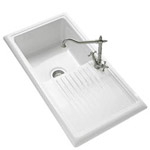Kitchen Sink Materials
Introduction
Until relatively recently, the range of kitchen sink materials from which kitchen designers could choose were very limited. Today’s technological developments, however, have widened the selection considerably. Listed below are each of the options, with pros & cons to allow direct comparison.
Stainless Steel
Stainless steel sinks have been with us for many decades, and as such can suffer from something of a old fashioned and basic reputation. While the cheapest kitchen sinks will indeed be made from stainless steel, the material is also extremely well suited to today’s sleek and modern kitchen decors, and makes an excellent match for a wide selection of kitchen taps and appliances. As a result, plenty of ‘designer’ stainless steel sinks are now available in large variety of shapes and sizes.

Sinks made from stainless steel can vary in thickness and/or grade. In the more expensive and better quality models, the basin is welded to the rest of the sink, such that it has a denser and stronger base to the bowl. You should be able to see a weld mark on the underside of a good quality stainless steel sink.
By comparison, cheaper sinks are made from a single, thinner sheet of stainless steel, where the bowl has been ‘pushed through’. This makes the basin weaker and more prone to flexing under pressure, even if one simply pushes ones thumb onto it.

- Cheap options available
- Strong but lightweight
- Hygienic
- Highly durable
- Heat resistant
- Stain resistant
- Easy to clean

- Surface can be scratched
Ceramic
Normally associated with traditional Butler and Belfast sinks, ceramic basins are usually made from kiln-fired porcelain or fireclay to form big, robust sinks, that are extremely hard-wearing.
Ceramic sinks, which are usually white or ivory coloured, have once again become a popular alternative to stainless steel, and unsurprisingly they are now available in several modern styles, as well as the old 'Victorian' ones to complement any set of kitchen units.


- Highly Durable
- Easy to clean
- Heat resistant
- Stain resistant
- Scratch resistant

- Impact damage will crack the sink
- Will break dropped crockery
- Heavier than stainless steel
Granite
Demand for sinks in alternative colours has lead to the development of granite-based materials which are marketed under various proprietary brand names. The sinks are manufactured from 80 – 85% natural granite, which is ground up, coloured, mixed with resin, then moulded and set into a range of sizes and shapes.
Comparable sinks are also available using a quartz base.


- Hard wearing
- Easy to clean
- Heat resistant
- Stain resistant
- Scratch resistant
- Impact resistant
- Colour permeates whole surface

- More expensive than alternatives
- Heavier than stainless steel
Asterite
This synthetic product, made by ICI, is a silicone-based material set with resin to make sinks in a variety of colours, shapes and sizes. Several companies have developed their own versions of asterite, usually through working with ICI, and these are marketed under a range of brand names.
A lower cost version manufactured from polycarbonate is also available, but these are not as strong or durable as those made from true asterite.


- Durable
- Heat, impact and stain-resistant
- Any surface abrasion can be repaired
- Can achieve ‘seamless’ look
- Homogenous pattern

- Heavier than stainless steel
Corian
This popular synthetic product, developed and manufactured by Dupont, is a combination of natural minerals which are fixed in a clear acrylic resin to form a solid, non-porous, semi-matt surface. Available in a limited range of colours, Corian® is also used to make worktops with a truly continuous surface.
The advantage of a Corian® sink, when combined with a Corian® worktop, is that the sink can be undermounted to the worktop to produce an uninterupted surface.

- Durable
- Heat, impact and stain-resistant
- Any surface abrasion can be repaired
- Can achieve ‘seamless’ look
- Homogenous pattern

- Heavier than stainless steel
- More expensive than similar alternatives
Copper
A distinctive and unusual look can be achieved in a kitchen when using a copper sink. These tend to be hand-made from a single sheet of copper which is alloyed with zinc for hardness, hammered into shape and then fired to develop the final product.
Copper sinks are available with a range of finishes, from a bright, polished look, through a uniform brown colour to an antique reddish-brown textured surface.

- Copper is a soft metal that is prone to oxidation, so these sinks should be wiped dry after use and waxed (with beeswax) periodically to avoid discolouration.

- Can be repolished with abrasive cleaners
- Lightweight

- Not hard wearing
- Easily scratched
- Dark spots develop with age
- Needs maintenance
Further information and useful links
- Find a Kitchen Sinks & Taps supplier near you
- Find a Plumber near you
- Find a Kitchen Fitter near you
- Find a Kitchen Worktop supplier near you
- Find a Kitchen Fixtures & Fittings supplier near you
Site Pages
Featured Articles





